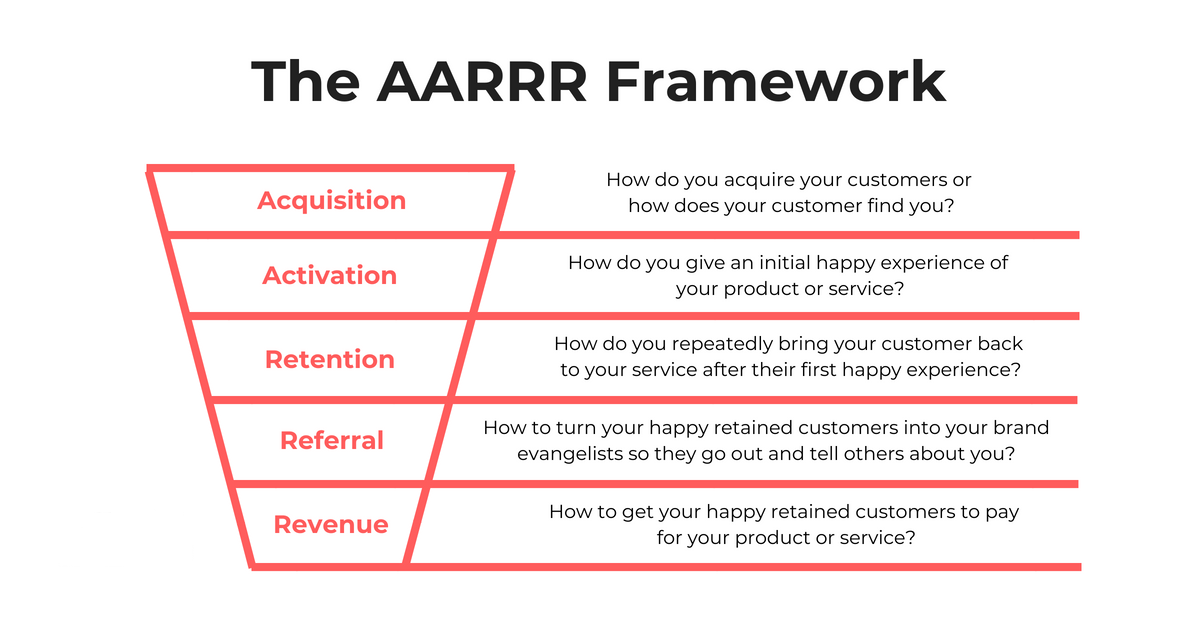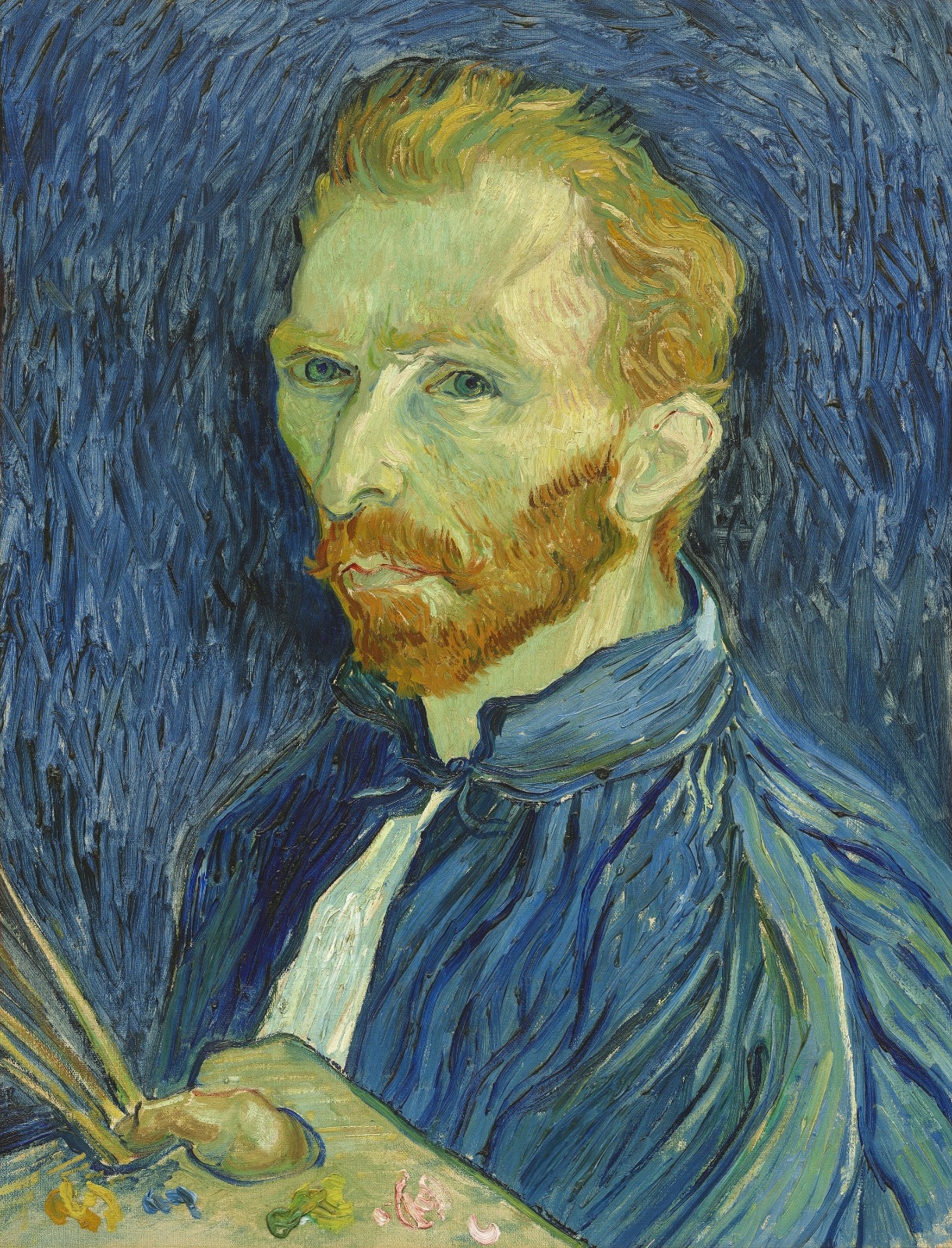
What is the Pirate Funnel or AARRR
As growth hackers, it is important to understand your sales funnel. It is a basic tool for business growth. Having a clear view of your funnel, right from the start, can really help you to achieve the growth you are looking for. Consequently, it is the basis for all successful growth hacks.
The AARRR funnel represents a client’s journey from start to finish. Ultimately, understanding the journey of your customer and where you can improve will help you to create a self sustainable cycle. This is a primary goal of growth hacking.
Each metric (Acquisition, Activation, Retention, Referral and Revenue), is just as important as the other, although most companies will have one metric, which performs better for them. Identifying your business’ “North Star metric” and where it sits in the AARRR or Pirate Funnel will help to drive long term success. We will look at the North Star metric in further detail below.
Optimising each step, will eventually lead to increased revenue. And will achieve the ultimate goal of growth.
Where did the Term, Pirate Funnel Originate?
Dave McClure, entrepreneur and angel investor and founder of 500 Startups, first used the term during a speech in 2007, titled: Product Marketing Metrics for Pirates: AARRR! It broke down a customer’s life cycle stages into 5 key areas: Acquisition, Activation, Retention, Referral and Revenue. It really simplified, the buyer’s journey of moving through the sales process. Since then, major tech powerhouses such as Airbnb, Twitter, Spotify, to name but a few.. have used the principle of pirate metrics, in their growth strategies. The results clearly speak for themselves. Once the preserve of the tech elite; Veksa now wants to bring these principles to all and any startups, scale ups and other businesses who are looking for growth. It aligns with customer lifecycle stages, helping growth hackers like Veksa, to focus their efforts on optimising growth goals.
The Pirate Framework Explained:
Dave McClure’s original motivation, was to demonstrate to businesses where they should be focusing their labours. All too many businesses fail, by not focusing their efforts where it really matters – growth. In other words, they may focus on areas, which do nothing to really grow their business and ultimately, increase their revenue.
He identified 2 key goals:
- To focus only on metrics, which would affect the health of the business.
- To use the correct data to measure their marketing and product’s success
Here are the key areas to focus on:
- Acquisition: How do you acquire your customers? Or, how does your customer find you?
- Activation: How do you give an initial happy experience of your product or service?
- Retention: How do you repeatedly bring your customers back to your service after their first happy experience?
- Referral*: How do you turn your happy retained customers into your brand evangelists so they go out and tell others about you?
- Revenue*: How to get your happy retained customers to pay for your product or service?
Of course, each business is different and there is more to creating a successful business than just applying a formula. However, the Pirate Funnel, really helps to break it down into the chunks, which really matter.
* I have seen instances where Referral and Revenue are switched around and awareness is added (see below) but the original funnel and the one we at Veksa always refer to is the one above.
Awareness:
In some instances – Awareness – is added as the first step of the funnel – this metric is measured by the total number of people your business reaches.
It was felt that the AARRR funnel without Awareness was too focused on sales.
Dave McClure did not include Awareness in his original AARRR funnel. As growth hackers, we are laser focused on growth. For us, Activation is almost always the first step in our funnel. When looking at the difference between digital marketing and growth hacking, awareness is often a distinction. A straight digital marketer will look to promote a product or brand. Brand recognition and brand awareness and promotion of a product or service is very much a goal of digital marketing. For us growth hackers, our goals are much more measurable and growth focused.
How to work your AARRR Metrics
Acquisition:
Acquisition is about driving traffic to your website and creating new leads. Eventually they should stat to purchase from you. There are various ways in which you can optimise this element of the sales funnel. This is about your customer taking action towards the end goal of revenue. You can attract customers to your website via SEO. Alternatively you could use PPC (Pay Per Click), so your customers can find you via Google and the SERPs (search engine results pages).
Social media can also help you in the acquisition stage of the sales funnel. Social media is a great way to connect with you audience. You can assert yourself and introduce your customers to the authentic face of your brand or business on social media. If you sell your products on Facebook or Instagram it is crucial to the acquisition process. Paid social media advertising is another route. Social media influencers are another great route to acquiring new customers. Other routes to acquisition include customer referral as well as customer retention.
Basically, once you have created the self sustainable cycle, your customers will come from other stages of the funnel to start the process again.
It is crucial to choose the right channel for customer acquisition. Understanding your customer persona and where to find your ideal customer is key.
Activation:
Activation is about your customer’s experience and what they do when they visit your website. If you are selling products on your site then the goal would be for them to purchase something, however chances are they won’t do this on a first visit. You want their experience to be a positive one, so they return again and again and eventually purchase. Activation can include sign ups to a newsletter. If you are offering a service then booking a telephone call or meeting via Calendly would class as activation. Are you able to offer your customers a free trial? If you really believe in your product or service and think your customers will too, then giving them the chance to try before they buy, is part of activation.
Basically, this is where a customer starts to see the value of what you have to offer. They are well on their way to becoming a paying customer and you are starting to nurture them through the sales process.
Retention
Ideally, you would like every customer who purchases from you to be a loyal lifetime customer and keep coming back for more. In order to do this, you have to ensure the customer experience is as good as it can be. Customer loyalty is extremely important to the success of any business. You must ensure that you are always ahead of your competitors and do not become complacent or take your customers for granted.
Customer feedback is key when considering the retention metric. Make sure your customers have the chance to let you know their feelings and take note of where you can improve.
Reward your loyal customers with some sort of retention program. Money off their next purchase is always enticing. Equally, if you are offering a service, then an elevated customer experience will keep your clients satisfied.
Referral
Once you have created a loyal customer, the next step is for them to evangelise to their friends and family. Word of mouth is very powerful in acquiring new customers and key to the self sustainable sales cycle we are striving for. It is a really important strategy to work out where your referrals are coming from. Creating a referral program is a good way to see who and where you are getting your referrals from. Referrals can be measured by number of signups, hits to your website or purchases. Once a customer has been referred they become part of the AARRR funnel and cycle.
Some of the most iconic growth hack examples have involved referral programs. Perhaps the most famous is Dropbox:
Dropbox created a referral scheme whereby their customers had the chance to get free space by recommending their friends or family. It was (and still is) a mutually beneficial scheme. By inviting a friend to join Dropbox, the friend and the user could earn 500MB of free space. Up to a maximum of 32 friends and 16GB of space. The scheme was a phenomenal success and is still going today. Key to its success was the ease at which someone could refer a friend. With the click of a social media share button, or using a specific link. Dropbox also offered its users the option to download their entire contact lists, so they didn’t need to send out each email individually.
The Dropbox program above, didn’t cost much in the great scheme of things and let to their user base growing exponentially. They really leveraged the referral element of the funnel. Their success today speaks for itself.
Revenue
The culmination of all the metrics above should be revenue! Once the cycle is in full flow, you should see a substantial improvement in the bottom line. When the cycle is working you should see a self sustainable cycle of growth. You are acquiring customers, who become repeat customers. They are telling their fiends and family, who in turn become repeat customers, tell their friends and the cycle begins all over again. Genius!
North Star Metric
The North Star metric is strongly connected to the AARRR funnel. It is basically the metric or measurable, which will most likely determine a company’s success. If you can work out what this is and fit it into the AARRR funnel, you can really start to leverage your business’ success. The 3 measures of a North Star Metric are: does it lead to revenue? Does it reflect customer value? Does it measure progress?
Examples of North Star Metrics
For example North Star metrics could be measured on the number of monthly active users. Facebook or LinkedIn use this as their North Star metric. An E-commerce site would likely measure the number of first time users to make an initial purchase. An SaaS business might measure their North Star metric as the number of free trials signed up for with over 3 users or monthly recurring revenue. Total watch time, total listen time, or read time are all examples of North Star metrics. It is much easier to grow a business if you have an agreed goal and are all working towards it. Every business will have its own North Star metric and it could be something very unique. Most businesses will depend on satisfied customers and generating profit, but getting really specific and identifying the measurable determining this, will really pay dividends in the long run.
Measuring the Pirate Framework:
Another key element of Dave McClure’s initial framework, was to demonstrate to businesses how vital it is, to keep measuring your growth metrics, to ensure, they are moving in the right direction. In other words, upwards! I’ve listed below his growth metric measurements:
Simply put, the pirate or AARRR funnel can be measured in the following way:
- Acquisition: Where/what channels do users come from?
- Activation: What % have a “happy” initial experience?
- Retention: Do they come back and visit over time?
- Referral: Do they like it enough to tell their friends?
- Revenue: Can you monetise any of the behaviour?
At Veksa, our work is based on the Pirate Funnel or Framework. We look at the whole customer journey and how we can improve it and maximise it to achieve explosive growth for our customers. It may sound simple. However, the actual reality and successful implementation of an AARRR strategy, actually takes considerable marketing skill and know how. This is Veksa. A premium growth hack marketing agency, that actually delivers real growth to its clients time after time.
To get to know more about our Growth Hack Plan, please visit and leave your details:




